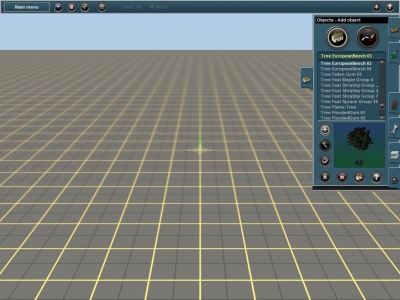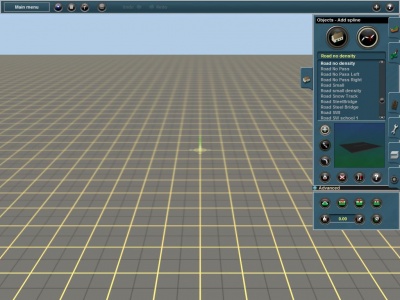Help:Objects Tab
Two different types of object assets exist in Trainz: object assets and spline assets. Adding and manipulating these assets in Surveyor Mode (F1) is accomplished by clicking on the Objects 'F3' tab in the Surveyor Tools Menu. Tools for assets directly related to tracks are provided separately under the Tracks 'F4' tab as described in detail at Help: Track Tools. Within the Objects Tools menu, two buttons at the top select between tools for "object assets" and tools for "spline object assets". These can be selected by typing 'o' or 's', but be careful as SHIFT-S will crash the program.
Contents |
Objects
Surveyor Menu on right shownwith Objects Tools selected.
 Add Objects
Add Objects
The default mode for the Objects Tab is Add Objects 'A'. The alphabetical list shown is all of the objects installed on your computer. Begin by scrolling through the list using the scroll bar or by clicking on the up or down arrows. The selected object (in yellow type in the window above the listing) shows as a rotating 3D object in the viewer window. Check that you are in Add Object mode (or click on Add Object 'A') to select this mode. Click on the terrain (LMB) and the selected object is placed wherever you click. You can repeat this multiple times to add a number of the selected object over an area. Objects are generally placed "correctly" with respect to the ground surface, but tools described below can be used to manipulate the object.
You can also search the objects listing. Click on the window showing the current selected object (in yellow type), press delete, then type in your search term. The list will move immediately to the best match for the search term. Since the search considers only the first match it finds, this method of finding an object is less than ideal.
In as much as your objects list is likely to become quite long and the search engine is not at all efficient, you may wish to create a personal picklist of the assets you use most frequently. See Create a Picklist.
 Move Object
Move Object
Select the the Move Object 'M' tool and click and hold on any object and then drag the object around the terrain to new positions.
 Rotate Object
Rotate Object
Select the Rotate Object 'R' tool and click and hold on an object while moving the mouse left and right to rotate the object. A display shows you the number of degrees of rotation.
You can set objects to “randomly rotate” or not by choosing the Randomly Rotate option in the Surveyor Options menu from the Main Menu.
 Get Object
Get Object
Click on the Get Object (G) tool and then Click on an object already placed on the terrain. The object selected now appears in the selection window. Change the mode to Add Object (A) and Click again on the terrain where you wish to place another copy of the newly selected object.
 Delete Object
Delete Object
Select Delete Object (D) then Click to delete an object. Continue Clicking to delete a number of objects. If you click on the wrong object, click on Undo (Ctrl-Z) to undo the last action and replace the last deleted object.
 Height Adjust
Height Adjust
Click on Height Adjust (H) to enable the adjustment of the height of any Object. Only objects which have been designed to be height adjustable will allow you to adjust their height. S Holding the Ctrl key in conjunction with this move will adjust the object’s height in increments of 0.1 units and holding the Shift key will change the height by units of 0.05.
 Edit Properties
Edit Properties
Click on Edit Properties (N). Then Click on any object in your route. A menu will then open up allowing you to edit the properties of the object.
Splines
Spline assets are long objects such as roads, power lines, fences, etc. A completed spline object has two “spline points” denoted by white, rotating circles at the ends. These spline points can be placed any distance apart by dragging one of the spline points across the terrain, stretching the object in the process. Additional spline points can be added to the spline to bend it.
 Add Spline
Add Spline
To create a spline, click on the Add spline 'A' button after selecting a desired spline asset from the listing of available splines. Click on the terrain to anchor the first spline point (called a vertex) and click again some distance away to place a second vertex. You will see white circles at each end of the spline segment. These spline points or vertices establish grab points on a spline that may be selected for moving or adding to a spline. Thus, to extend the spline, click on a vertex and drag, clicking once more nearby. Note that the created spline curves between each vertex. Holding down the Ctrl key will lay out multiple spline segments with a new vertex each time you hit the LMB. Release the Ctrl key before setting the last vertex to end the spline.
Splines recognize other splines as being of a certain type (roadways, for example) and will connect at a common vertex. Attempting to connect dissimilar types (or just laying another spline type nearby) will generate the error message: "Error: Cannot attach to this vertex". You can avoid this error and lay two dissimilar splines close to one another by holding down the Shift key. The Shift key prevents even compatible vertices from joining, so laying out a spline while holding the Shift key produces segments that are not joined to each other.
 Move Spline
Move Spline
To move a spline object. select the Move spline 'M' tool and click (LMB) and hold on a vertex, then drag the spline point to a new location. Release the LMB to complete the move. To avoid a vertex from linking up to another, compatible vertex close by, hold the Shift key down while making the move.
 Split Spline
Split Spline
The Split spline 'Q' tool breaks the connection at a vertex, creating two independent sections. Click (LMB) on a non-end vertex to break a spline. Because a spline will curve between vertices, this tool can be used to make corners, as in a fence line.
 Get Spline
Get Spline
Click on the Get Spline (G) tool and then Click on a spline object already placed on the terrain. The spline object selected now will appear in the selection window. Change the mode to Add Spline (A) and Click again on the terrain where you wish to place the newly selected spline object.
 Delete Spline
Delete Spline
Click on Delete Spline (O) then click on a section of spline between two adjacent white circles to remove unwanted spline sections. If you delete a section that is not an end section of a spline, the spline will be split into two splines.
 Toggle Traffic
Toggle Traffic
In the more recent versions of Trainz, turning traffic on or off on a route is accomplished in Edit Environment under the Edit Menu (second from left in the top menu bar). Select Location to open the Environment - Location window, where you can enable or disable traffic on your route. See Toggle Traffic.
 Edit Properties
Edit Properties
The Edit Properties 'P' tool can be used to name a spline and also specify layer (route or session) where the new name will apply. Click on the spline object to see the name of the spline and edit the name as desired.
Advanced
Click on the Advanced Menu (Shift F3) to access even more tools. A drop down menu is then revealed.
 Spline Height
Spline Height
The Spline Height (H) tool can be used to raise or lower the height of certain types of splines (for example catenaries or road bridges). Click on Spline Height then Click and hold on a spline point (the white circle) and drag the mouse forward or backwards.
 Delete Spline Point
Delete Spline Point
Click on Delete Spline Point (X) and then Click on a white spline circle to remove unwanted spline points. You cannot delete an end spline point, but you can delete the whole section using the Delete Spline (D) tool.
 Insert Spline Point
Insert Spline Point
Click on Insert Spline Point (I) then Click between two existing spline points. Notice that a new spline point is created.
 Smooth Spline
Smooth Spline
Smooth Spline (S) levels the track between two spline points, bringing the land up or down to match the levelled spline.
 Get Vertex Height
Get Vertex Height
Click on the Get Vertex Height and Click on the highest spline point on your spline. The height is displayed in the Height Value box.
 Apply Vertex Height
Apply Vertex Height
Click on Apply Vertex Height then Click on another spline point. The spline point is raised to the same height as you first vertex.
 Remove Gradient
Remove Gradient
Click on Remove Gradient and then Click on a spline section to remove the gradient between two spline points.
Trainz Wiki
 |
More Tutorials and Guides to Using Trainz |

